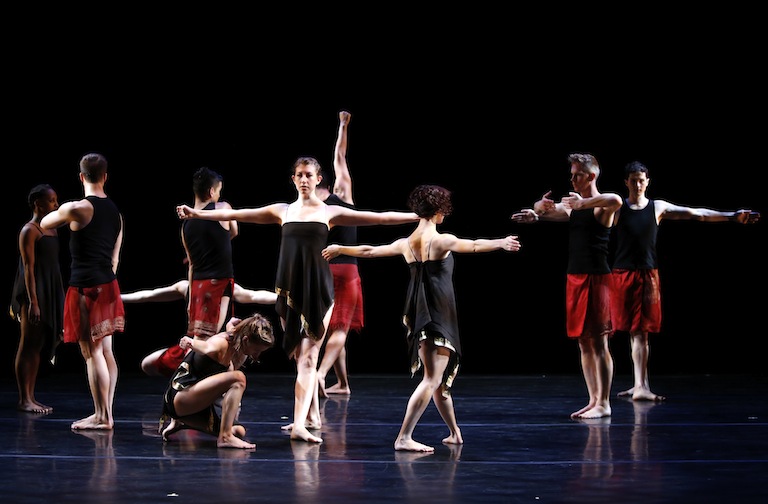
“I want to die …
A voice falls on the audience from above: it is high, resonant and plaintive. The guitar accompaniment is slow and simple, reminiscent of a folk song. “I want to die like Lazarus did”—the phrase repeats over and over, those are the only lyrics. On stage the San Francisco Girls Chorus, young women, really, in modest black gowns, sing harmonies of the phrase. To stage right a man in a black suit lies on his back, motionless. The curtains are shut except for a two-foot gap between the bottom edge of the curtain and the stage floor.
The man is barefoot and he is Stephen Petronio, the choreographer and director for a company of ten splendid dancers. And this is the opening of the company’s latest piece, “Like Lazarus Did.”
In his notes on the dance, Petronio relates that he was inspired by the composer Son Lux, who has collaborated with Petronio on three other commissions. Lux had sent Petronio a book of American slave songs, which had come down to the present moment through oral tradition. The ephemeral nature of the songs echoed Petronio’s sense of dance, which because it is based on movement is always disappearing, replacing itself with the new and unexpected.
Along with this idea of the quickly passing were the lyrics of these songs, mostly gospel in style and few in words, and promising resurrection. Petronio expands this Christian theme to renewal and rebirth, citing in his comments rebirths as diverse as the phoenix and Sleeping Beauty. This concept is, after all, the choreographer’s calling: to remake and renew the body’s vitality through movement. Without the trappings of religion, mythology or folklore.
When the curtain opens after the first song, the singers have filed off-stage to position themselves as an accompanying musical body in the balconies over the audience, Petronio has disappeared as if by magic from the stage, and the dancers are arranged across center stage. Behind them, high above the stage lies visual artist Janine Antoni, motionless in a red metal rescue stretcher, with semi-transparent castings of her body parts—legs, arms, buttocks, bones—suspended above her. From her hand dangles a naked light bulb in a red cage.
Antoni provides a kind of ongoing visual metaphor of the dead, or nearly dead, throughout this minimally lit production of smoky diagonal spots and deep stage darkness. But what really hold the piece together are the dancers as they move through a series of non-stop combinations.
… like Lazarus did.”
The choreography depends on tight, small, stylized moves that cover a range of simple body undulations to classical steps of passés, sautés and arabesques to contortions and writhings. Little is provided in the sense of narrative, except for, perhaps, a gradual shedding of clothes from white androgynous nightshirts to flesh-colored knickers.
All of the movements are characterized by constraint, the mastery of the body in smallish human dimensions rather than a constant pulling away from the earth’s gravity: no grands jetés are seen. Jumps when they occur are en tournant, the body swiveling around itself to land in the same place from which the dancer first launched himself.
Constraint and a continuous restlessness. The multiple entwinings of the dancers—there are only three solos in the hour-long performance—have the dancers gripping each other as if they were supports more than objects of love and desire. It’s fascinating to watch. Brilliant in its obsessive detail. And a tribute to the absorption with humanity that is dance’s high calling.
Review by Jaime Robles
Stephen Petronio Company’s performance of “Like Lazarus Did” was performed at Yerba Buena Center for the Arts, March 14–15, 2014, as the final dance performance of San Francisco Performances.
